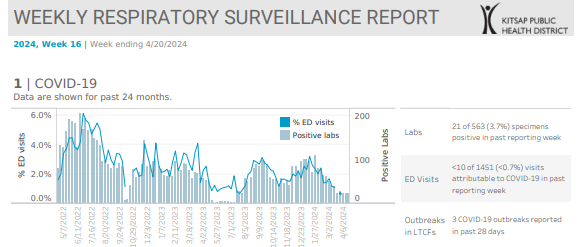-
Kitsap Respiratory Illness Report: April 14-20
Advisory or Update, Communicable Disease and Immunization Update, Communicable Disease Data Report, COVID-19, Health Advisory, Health Alert, Infection Control, Influenza, Influenza Update, News and Alerts, News and Update, Provider Resources, Respiratory Illness Report, Respiratory Illness ReportClick here to access week 16 of the Kitsap Respiratory Illness Report. In the week ending April 20, local indicators for influenza, COVID-19 and respiratory syncytial virus (RSV) remained low. Fewer than 10 emergency department (ED) visits were attributable to any one of the three monitored respiratory viruses (COVID-19, influenza, RSV). Kitsap sentinel reporting labs reported…
-
Hepatitis A Fact Sheet
Overview Transmission: Fecal-oral. Incubation Period: Average 28-30 days (range 15-50 days). Symptoms: Anorexia, vomiting, abdominal pain, fatigue, followed by jaundice. Severity of illness increases with age. Infectious Period: 14 days prior to onset of jaundice to seven days after onset of jaundice. Infants can excrete virus in the stool for longer periods of time. Epidemiology:…
-
Health Advisory: Zika Testing
Action Requested Know how to order appropriate Zika virus testing through commercial laboratories. Background Because testing for Zika virus is now widely available through commercial laboratories, testing for Zika virus at Washington State Public Health Laboratories is now limited to: Patients for whom cost is a barrier to testing. Infants with possible congenital exposure to…
-
Lice in Schools
What procedures should our school follow if a student has head lice? Head lice are tiny parasites that can live on the human head. They survive by sucking blood from the scalp. Lice eggs (called “nits”) can attach to strands of head hair. Lice can cause the head to itch, but have not been proven…
-
Meningococcal Disease Fact Sheet
Meningococcal disease is a sudden, severe illness caused by the bacterium Neisseria meningitidis. The disease manifests most commonly as meningitis and/or meningococcemia, but may also cause pneumonia, arthritis or pericarditis. The symptoms include sudden high fever, chills, severe headache, stiff neck and back, nausea, vomiting, purpural rash, decreased level of consciousness, difficulty breathing and seizures.…
-
Perinatal Hepatitis B
Guidelines for Prenatal Care Screen every pregnant woman for HBsAg early in each pregnancy according to Centers for Disease Control and Prevention and American College of Obstetricians and Gynecologists recommendations. HbsAg testing should be repeated late in pregnancy if the woman is HBsAg negative and is at high risk of hepatitis B infection (e.g., injection…
-
Hepatitis B Immunization and Healthcare Workers
Healthcare Worker Immunization Pre-exposure evaluation for healthcare personnel previously vaccinated with complete, ≥ three dose hepatitis B vaccine series who have not had post-vaccination serologic testing* Source: CDC—MMWR December 20, 2013. * Should be performed one to two months after the last dose of vaccine using a quantitative method that allows detection of the protective…
-
Latent Tuberculosis Infection Treatment Guidelines
High-Priority Candidates for Latent Treatment Infection (LTBI) Treatment Positive QuantiFERON-TB Gold (QFT) (>0.35 IU) Tuberculosis Skin Test (TST) ≥5 mm HIV-positive people. Recent contacts of person with infectious tuberculosis (TB). People with fibrotic changes on chest x-ray (CXR) suggestive of previous TB; or inadequate treatment. People with organ transplants or immunosuppression therapy. TST ≥10 mm…
-
Infection Control Guidelines
Standard, Contact, Airborne and Droplet Precautions Standard Precaution When to Use Standard Precautions During all patient encounters—prevents the spread of bloodborne pathogens such as HIV, Hepatitis B and Hepatitis C. Reason to Use Standard Precautions Protects the healthcare worker from patient’s potentially contaminated body fluids and prevents the spread of disease to others. Components of…
-
Controlling Norovirus
You may hear norovirus called “the stomach flu.” Some viral illnesses that cause vomiting and diarrhea are caused by norovirus. You can become infected with norovirus many times in your life. Norovirus Is very contagious. Norovirus can spread quickly in places like daycare centers, nursing homes, schools, restaurants and cruise ships. Causes diarrhea and vomiting,…
-
Tdap and Pregnancy
Pertussis is a serious disease for young infants. Pertussis epidemics occur in the United States every three to five years. Even though we have a vaccine, pertussis is a common infectious disease. There are 10,000 to 40,000 cases and 10 to 20 deaths per year.[1] Pertussis is most serious in infants younger than six months.…
-
Chlamydia Diagnosis Follow-up
Provider Checklist Patient treatment for chlamydia is not complete without partner treatment. After receiving a positive chlamydia result, check the following steps to help stop the spread of chlamydia and to protect your patient from reinfection: Provide patient education on essential points: Take medications as prescribed. Do not have sex for seven days after treatment,…
-
Hand Hygiene In Healthcare Settings
What is hand hygiene? Hand hygiene refers to the use of hand washing with soap and water or alcohol hand sanitizer (60% alcohol or greater) in order to reduce infection rates, reduce transmission of antimicrobial resistant organisms and stop outbreaks of communicable disease. Why is hand hygiene important? When should I use hand hygiene? How…













